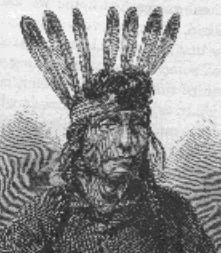[1]

We had proceeded but a little ways when we came upon four dead bodies -- three men and one woman -- all horribly mutilated. Our captors had committed the murders. The men had been mowing, and the woman had been raking hay. Their scythes and pitchforks lay near -- the woman had a pitchfork sticking in her person, and one of the men had a scythe sticking into his body. Cut Nose gleefully told that he had killed this man and described how he did it. The man was mowing, he said, and he went up to him in a friendly manner and offered his hand, and as the white man threw down his scythe and reached out his hand the Indian drew his knife and like a flash plunged it into the white man's breast, just under the chin, whereupon the white man grasped him around the waist and both struggled for the mastery, when they fell -- the white man on top. In working the knife into his breast the Indian got his thumb into the white man's mouth and "got bit." The knife in the hands of the Indian soon touched a vital spot and the white man rolled off dead. Cut Nose held up his bitten thumb. It was bitten and chewed, and was lacerated most horribly.
This fiend in human shape, this man Cut Nose, presented a most forbidden [sic], horrifying spectacle. With his bloody thumb he had besmeared his naked body, with his blackened face and long bushy hair like a Zulu's, and a half nose (one of his nostrils was missing) he was by far the ugliest looking and most repulsive specimen of humanity I had ever seen. [Samuel Brown's Account, Through Dakota Eyes]
[2]
The most repulsive-looking prisoner was Cut-nose, some of whose acts have been detailed by Samuel Brown. He was the foremost man in many of the massacres. The first and second days of the outbreak he devoted his attention particularly to the Beaver Creek settlement, and to the fugitives on that side of the river. I will give a single additional instance of the atrocity of this wretch and his companions. A part of settlers were gathered together for flight when the savages approached; the defenseless, helpless women and children, huddled together in the wagons, bending down their heads, and drawing over them still closer their shawls. Cut-nose, while two others held the horses, leaped into a wagon that contained eleven, mostly children, and deliberately, in cold blood, tomahawked them all---cleft open the head of each, while the others, stupefied with horror, powerless with fright, as they heard the heavy dull blows crash and tear through flesh and bones, awaited their turn. Taking an infant from its mother's arms, before her eyes, with a bolt from one of the wagons they riveted it through its body to the fence and left it there to die, writhing in agony. After holding for a while the mother before this agonizing spectacle, they chopped off her arms and legs, and left her to bleed to death. Thus they butchered twenty-five within a quarter of an acre. Kicking the bodies out of the wagons, they filled them with plunder from the burning houses, and, sending them back, pushed on for other adventures.
[Heard, The History of the Great Sioux Uprising and Massacre]
